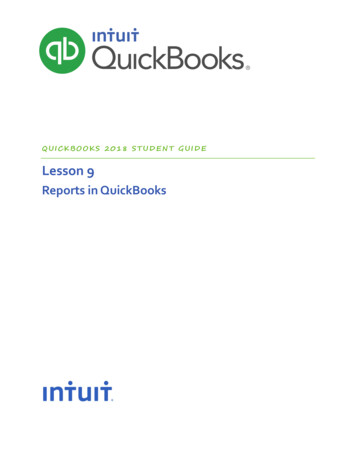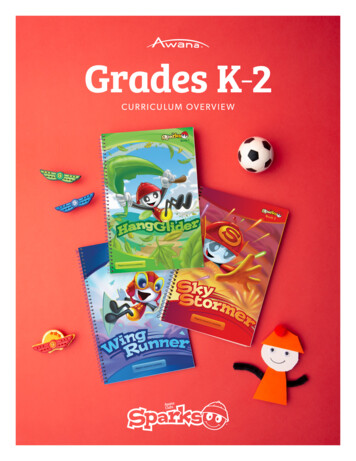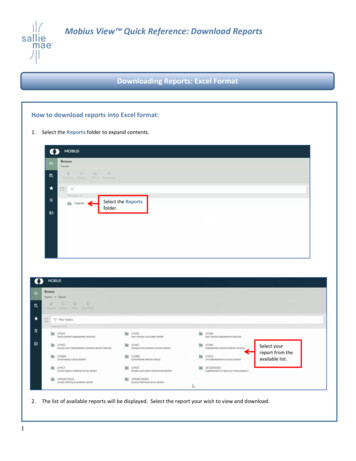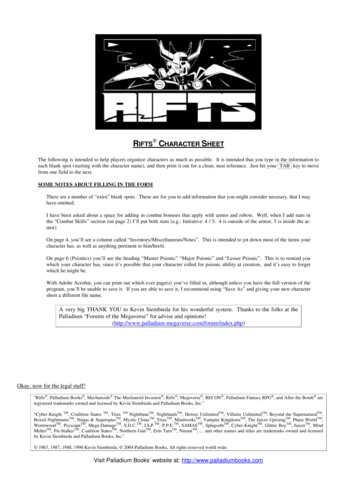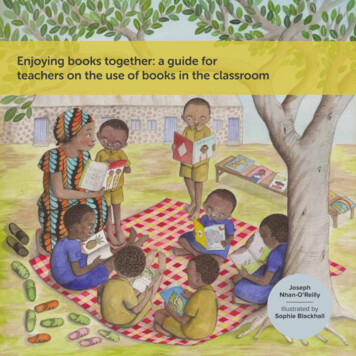
Transcription
Enjoying books together: a guide forteachers on the use of books in the classroomJoseph Nhan-O’ReillyIllustrated by Sophie Blackhall
About this guideThis guide has been produced by theRwandan Children’s Book Initiative,a project of Save the Children.The aim of the guide is to introduce Rwandanteachers to the importance of written materialand books and to share some ideas for howthey can be used in the classroom to improvestudent’s learning.‘Using books in the classroom’ begins withsuggestions about how teachers and studentscan increase the amount of written material intheir classrooms.It then looks at books in particular, with the aimof helping teachers understand the types ofbooks available and to begin thinking aboutwhat makes a good book for children.ContentsThe guide then goes on to look in some detail attwo approaches for using written material withstudents in the classroom:The importance of reading4The classroom environment6 teacher read aloudsBooks for children9 independent reading.Using books in the classroom10Teacher read alouds13Independent reading21Managing your book collection26Organising and displaying your books29Caring for books30Getting Rwanda reading32The Rwandan Children’s Book Initiative34Acknowledgements35The introductions to both of these approacheshave been designed to encourage teachers tothink about new ways in which books can beused, to test these out with their students andto discuss these approaches with their fellowteachers.Finally, the guide includes some suggestionsfor how to manage a classroom book collection,including organising, displaying and caring forbooks.This guide will be provided to all teachers whoparticipate in the Rwandan Children’s BookInitiative’s teacher training sessions, but it canalso be used on its own.We hope you find it useful!‘Using books in the classroom’ is also available in Kinyarwanda. Copies can be orderedby emailing rwanda-cbi@savethechildren.org or phoning 250 252 5729213
The importance of readingBeing able to read is a valuable skill.People who can read have access to printed information availablein books, newspapers, magazines and on the internet.For children at school being able to read is essential.Children who fail to read in the early grades fall further behindeach school year, because reading ability is progressively usedas a tool for acquiring other types of knowledge.Learning to read is essential in order to read to learn.As a teacher, helping your students to read will make a lasting positivedifference to their time at school and more generally to their lives.5
The classroom environmentExposure to written and printed textsis essential for developing the abilityto read. Displaying your students’ work on the wallsof your classroom creates an interestingteaching environment and shows yourstudents that you value their writing.But in many African countries, communities ingeneral and schools in particular experience alack of books and other printed material. Show your students different kinds ofreading material. For example you couldhold up a letter that you have received froma friend or even an official document orgovernment announcement. Show them a book that you have read andtell them about it and why you enjoyed it. Finally, create a reading corner whichcontains your classroom book collection,however small, along with items like yourreading cards. Having a dedicated spacefor your books and reading can help makereading a natural and enjoyable part ofclassroom life.Teachers have an important role to play inimproving their students’ access to writtenmaterial. You can make your classroom a richliterate environment in which lots of printedwords are on display and where print material isavailable to students.Here are some ideas: P roduce your own word cards which youcan use to label the items in your classroom,such as the chairs and desks. D evelop reading cards which might have asimple drawing and the word for the objectdepicted underneath it. P roduce your own posters and charts anddisplay these on the walls of your classroom.Point to them as you tell your students whatthey say.Take time to produce and display written material.Doing this will make your classroom moreinteresting and make an important contributionto improving your students’ exposure to print,which will improve their learning.7
Books for childrenKnowing what a book is and how touse it, including how to hold it andhow to turn its pages are part of theskills that make a person literate.This is not the place to store text books, yourclassroom library should focus on books thatare read for pleasure.Giving young children access to books istherefore critical to supporting their abilityto read.All books used in Rwandan classrooms mustbe approved by the Rwandan Education Board.REB approves books for use in a range of years(1 – 3 and 4 – 6) which should help ensurethat the books you have in your classroom areappropriate for both the age and reading levelof your students.Schools have an important role to play inensuring children get to see and share books.To ensure this happens, every classroom shouldhave a collection of books that children can use.You do not need a large number of booksto create a great book collection. A few wellchosen books, especially in the early years ofprimary school, can introduce children to theimportance and magic of reading.Types of booksIt would be good to include in your collectionfiction, non-fiction and picture books so thatchildren understand that there are differenttypes of books.Approved booksExposure to books is the beginningof literacyThe most important thing to remember isthat children need to see and use books tobuild the skills and knowledge that will makethem effective readers.As a teacher you can play an important role insupporting your students’ reading and learningby ensuring that they have access to books inthe school classroom and that using books, bothalone and together as a class happens every day.9
Using books in the classroomThere are a variety of simple and veryeffective ways of using books in theclassroom which will support yourstudents as they learn to read.This guide will introduce you to two importantand very useful approaches, namely teacherread alouds and independent reading.Teacher read alouds are when a teacher readsa book to the class or a group of students.Independent reading on the other hand involvesencouraging students to choose to read,selecting what they want to read and then beingable to share what they have read.Varying your teaching methods will help tosustain the enthusiasm and engagement ofyour students.You can use these approaches each day andnot just when dealing with ‘teaching reading’but when you have written material to use forany subject.Once you’ve read about these approaches,you might like to talk to your fellow teachersabout them, asking if they’ve used them andhow they found the experience.But most importantly we hope you will try theseapproaches out yourself and that they becomea useful part of your teaching methods.These approaches will help you to meet thediverse needs of your students and ensurethat the way in which books and other writtenmaterials are used is varied and interesting.11
Teacher read aloudsTeacher read alouds are when you read a book to theclass or a group of students.When using this technique you read the book aloud so that eachstudent, regardless of their ability, is engaged and is able to enjoy thewords and story.The inclusive nature of a teacher led read aloud session and thefact that it’s done together often makes it the activity within the schoolday that children most look forward to, especially in the early years.13
The teacher read aloud session1. Introducing the bookThere are four parts to a successful read aloud session:1. Introducing the book2. Reading the book3. Talking about what you are reading4. Reflecting on the sessionA read aloud session can last up to 30 minutes each day,but with younger students might be as short as 10 mins.Before you start you need to make sure thatall your students can see the book and its writing clearly.Introducing the book is done with the aim ofhelping your students prepare for the story.Your introduction should be brief and shouldinclude identifying the title, author and illustrator.You can then discuss the cover illustration,asking the students what they think thestory might be about using the coverillustration as a clue.This is where ‘big books’ are useful.You can encourage them by asking them,“and then what happens?”However if you don’t have access to big books then you mightuse a normal size book with a smaller group of your studentsso that all of the students can see the words and pictures.You can also ask your students to tellyou their own story based on the coverillustration.You can vary the books you use for your read aloud sessions,choosing a different book each time or reading the same book anumber of times. If the story is good children will love returningto the same book and becoming increasingly familiar with thebook’s words and sequence of events.15
2. Reading the bookOnce you’ve finished the introduction you can begin reading thebook. With younger students you can use a pointer or yourfinger to point to each word as it is read. This will help themconcentrate on the words and match the written wordswith how they sound when read. With older students it isnot necessary to point to every word.However, you can point to draw attention to words,information and pictures to help your studentsunderstand the significance of these things.Using pictures to encourage your students topredict words and meanings is a particularlyuseful thing to do when sharing a book in thisway.3. Talk about whatyou’re readingWhilst reading the book, you should stopoccasionally to discuss what you’re reading.You can ask your students questions that drawon the story. They can include questions aboutwhat’s already been read such as, “Why do youthink the character did that?” or “How do youthink the character feels?”A wonderful way of encouraging children to talkabout a book that’s just been shared, is to askthem to discuss the book in small groups of upto six students, answering questions like whatthey most enjoyed about the book.You can also try to relate the book to thechildren’s own experience. For example, if astory is about a bicycle, you can ask children,“Do you like bicycles?” and “Do you knowanyone who owns a bicycle?”You can also ask your students to predictwhat will happen next, with questions such as“What do you think she’s going to do now?”This shouldn’t detract from the reading of thebook, but should be used to complement andenrich the reading.The aim is always to help childrenmake sense of the text.You should also discuss the book afteryou’ve finished reading it.This might involve asking your studentswhat they thought of the book, whetherthey liked it, and who their favouritecharacter was.17
4. Reflecting on the sessionOnce the session has finished it is important for you to reflecton how it went and to consider how your students interactedwith the text. You might want to write your reflections in yourlesson planning log book.If you are teaching younger children you can note their growingunderstanding of how printed words work, observing who amongyour students is focussing on the text, who is quick to join in withthe reading and who asks questions about the text.If you are teaching older children you can use your read aloudsession to gather useful information about your students’comprehension, vocabulary and their ability to distinguishbetween different types of books.You should use your reflections to think about how to conductthe next session.19
Independent readingIndependent reading involves supporting yourstudents by setting aside time for them to read ontheir own, allowing your students to select whatthey want to read and then encouraging them totalk about what they have read.There are four aspects to supporting your students to readindependently. These are:1. Choosing reading material2. Creating space and time for reading3. Responding to what’s been read4. Developing a reading culture21
1. Choosing reading materialAs their teacher you have an important role inproviding books for your students and doingwhatever you can to expose them to the varietyof reading material available.The books in your classroom book collectionshould reflect a balance between familiarfavourites and new material, fiction and nonfiction books and both books that are easyto read and more challenging material forexperienced readers.Whatever you have available the idea ofindependent reading is that your students geta chance to select what they want to read ontheir own.To help your students choose from the widestselection of books available you might like toplace each of the books available on a mat, sothat the cover of every book in your collectioncan be seen by your students.Seeing the cover illustrations in this way, ratherthan just the spines, often encourages childrento look at a book that they might not otherwiseconsider.You can help your students choose what theywould like to read by encouraging them tothink about what the book they are looking atmight be about, to think about what they mightlike about the book and even to begin readingit to see if it is at the correct reading level fortheir ability.2. Creating space andtime for readingYour students should have opportunities to readindependently every day.You can support this by putting aside time in theschool day for independent reading, beginningwith five or ten minutes and gradually increasingthe amount of time. Older students who havemore experience reading should be able to readon their own for longer periods.You can make independent reading moreenjoyable by making it a special part of yourstudents’ day. You might choose to do thisby allowing your students to take their bookoutside and read under the shade of a tree,or to sit on mats in a corner of your classroom,rather than at their desks.23
3. Responding to what’s been read4. Developing a reading cultureIf your students are to enjoy and understand the books they’ve readthey need to have opportunities to talk and write about them.You have an important part to play in supporting your students’ability to read and instilling in them an appreciation for reading.Talking in small groups of between four and six students about astory, picture book, article or novel is a valuable way for students tounderstand what they’ve read.You can do this by: Encouraging your students to always carry a book withthem to read during any spare time they have.Towards the end of an independent reading session, where childrenhave already been given the opportunity to select a book and thenstart reading it, you might ask the children to form pairs and share thebook they’ve been reading with their partner, telling their partner whatthe book is about and whether they liked it or not and why. aking a schedule of the times when independentMreading can be fitted in at home. I nviting your students to talk about a book that they arereading with their parents or carer and reporting backon the discussion at school the next day.In this way, your students will learn how to talk about and respond tothe books they have read.Above all, teachers who love books and reading will find it easyto create a community of readers within the classroom. You canhelp by encouraging your students to talk about the books theyare reading and to ask questions or seek clarification about wordsand ideas they don’t understand.Encouraging your students to respond to what’s been read canhappen in lots of ways.You might also ask your students to draw a favorite scene from thebook they’ve just read, to write a short summary of what they’ve reador to make a presentation to the whole class on their favourite part ofthe book.By doing this you will see students reading to and with eachother, helping less able students and generally enjoying theopportunities that books provide.25
Managing your book collectionOnce you begin to develop a collection ofbooks, you and your school need to decidehow to store them.The difference is that textbooks are acurriculum-specific book, where all childrenfollow the same book in the class, whereasnon-textbook materials are more varied, andcan include picture books, stories or readers,general non-fiction, and reference books.There are various ways in which you canchoose to store your books.Textbooks may need to be managed in quitedifferent ways to books that aren’t textbooks.However and wherever you store your booksthe most important thing is to ensure that yourstudents have easy access to them.Because we’re trying to ensure children haveas much exposure to books as possible therecommendations that follow are for storing anddisplaying your books in your classroom ratherthan anywhere else in your school.Books are a valuable resource andneed to be managed and cared for.The easiest and most effective way to helpensure this is to store your books in theclassroom. Storing books elsewhere, like inan office or staff room, means it will be moredifficult for your students to get to and usethe books.Remember, the advice and suggestions in thisbook refer to books that are not textbooks.27
Organising and displaying your booksKeeping your book collection in yourclassroom has lots of advantages: ou can ensure the books in your collectionYare appropriate for the age and ability of thestudents in your class. You can be involved in all aspects ofestablishing and looking after the books. Thisoften helps ensure you feel ownership for andunderstand the contents of your collection. Books are easily available to you and yourstudents to supplement your lessons andencourage reading at every opportunity.BookshelvesSome schools will have received classroombookshelves from the Rwandan Children’sBook Initiative.These shelves have been designed to providea simple, accessible way of storing anddisplaying your books. The shelves can alsobe locked for security.Displaying some of your books with their coversfacing your students is an excellent way ofincreasing their exposure to books.Organising your booksThe best way to start organising your collectionis to split the books into fiction and non-fiction.Your story books can be organised intoappropriate categories such as ‘animals’,‘adventure’ and ‘fantasy’.It might also be worth organising your bookcollection according to grade or reading level,with easier books clearly grouped together.If you have English books in addition to books inKinyarwanda keep them separate.Keep the system simple and remember makeyour book collection accessible, attractive andfun and do everything you can to encourageyour students to browse the collection ofbooks often.The shelves allow you to choose a selection ofbooks and to display them, either on the doorsof the shelves or on the top.29
Caring for your booksBooks are a fantastic but expensiveresource and need to be looked aftercarefully.If you do the following things your bookcollection will remain in good order for longer: D ust the shelves regularly so that the booksstay clean. Wipe the covers of the books too. K eep the shelves and books away from anydamp or wet areas so that the books stay dry.Think about this when you decide on whereto put your bookshelves. E nsure that before a session which involvesusing the books that your students haveclean, dry hands. You might want to takeeveryone to wash their hands before anindependent reading session. Washinghands is good for children’s health too, sopracticing and encouraging hand washing isa good thing. Teach students and other teachers not tobreak the spine of books and to handlethem carefully. If the cover or the spine a book is damaged,repair it straight away. Your school should have a store of tape,glue and cardboard, for use when bookshave been damaged. If a book has been badly damaged andis unreadable, it should be removed fromthe shelf.Even though we want to ensure that booksare looked after properly, this doesn’t meanwe don’t want children handling them – wedo! Clean books on shelves that haven’t beenhandled and read haven’t served their purpose.31
Getting Rwanda readingReading opens up our understandingof the world. Through reading we canfind out what’s happening in our localcommunity or discover a communityin a faraway land.Reading also gives us the power to discoverwhat others have written thousands of yearsago and to understand the technology andprocesses that are shaping our future.Reading has the power to change our lives.Improving early grade reading and promotingreading is a priority of the Government ofRwanda in general and for the RwandanEducation Board in particular.The Rwandan Children’s Book Initiative ispleased to support the Rwandan Government’sambitions to get Rwanda reading.As a teacher you have a critical role to play inhelping transform your students’ lives, includingby helping your students to read.We hope you’ll be inspired by this simpleguide to produce more written material for andwith your students and to use the books thatare available in your school and classroom tosupport your students to acquire and developtheir reading skills.We have also produced a simple companionbooklet which aims to support parents andcarers to promote literacy at home.Both guides are also available in Kinyarwanda.33
The Rwandan Children’sBook InitiativeThe vision of the Rwandan Children’sBook Initiative is more childrenreading more and better books.We recognise that achieving that visionrequires action at a variety of levels in supportof a dynamic literate environment, includingimproving the availability, appropriateness,accessibility and use of books.As part of our efforts to increase the availabilityof high quality, age appropriate locallanguage children’s books we work to supportimprovements in the knowledge, skills andcapacity of the Rwandan book sector, includingauthors, illustrators, designers and publishers toproduce better children’s books.We then purchase books from local publishersthat meet our standards and then distributethose books to schools and communities.AcknowledgementsTeachers and principals from our partnerschools receive training and support in bookmanagement and use. Parents in communitiesin which we are working receive support andencouragement for using books with theirchildren.We are also committed to supporting nationaland local policies that will help deliver a richerliterate environment.The Rwandan Children’s Book Initiative is part ofa growing global network of national Children’sBook Initiatives that are being established bySave the Children.This guide was written by Joseph Nhan-O’Reillywith the assistance of Richard Germond andSofia Cozzolino.Produced byRWANDANThe illustrations throughout the guide are byworld renowned illustrator Sophie Blackall.www.sophieblackall.comA project ofThe guide was designed by Creative Coop.www.creative.coopThe teacher training programme associated withthis guide was developed in partnership withrepresentatives of the Rwandan Education Board,district education officers, principals, teachers and arange of other education sector colleagues duringthe course of 2013. We are extremely grateful for theircooperation and assistance.The Rwandan Children’s Book Initiative is supportedby Innovation for Education, a partnership betweenthe Governments of Rwanda and the UK.In partnership withFunded by Save the Children, 201435
‘Enjoying books together’ has been producedby the Rwandan Children’s Book Initiative.This guide introduces teachers to theimportance of written material and booksand provides ideas on how books and otherprinted material can be used in the classroomto improve student learning.Our vision is more children reading moreand better books.We hope this guide helps you make thatvision a reality for the children in your class.RWANDAN
types of books. This is not the place to store text books, your classroom library should focus on books that are read for pleasure. Approved books All books used in Rwandan classrooms must be approved by the Rwandan Education Board. REB approves books for use in a range of years (1 - 3 and 4 - 6) which should help ensure


